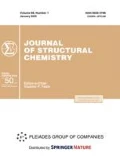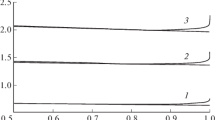Abstract
A model for the interaction between neutral molecules in amorphous isotropic environment is considered. The intermolecular interaction energy contains three independent groups of quantities describing non-polar forces, polar forces, and hydrogen bonds. Respectively, each of the forces is represented by its own molecular descriptor: generalized charge, dipole moment, and two numbers showing the ability of the molecule to be the donor or the acceptor of the H-bond. The H-bond contribution to the total energy of intermolecular interaction is described as a product of some quantum-mechanical threshold value and the probability of correct arrangement of interacting molecules. The accuracy of the model is verified by applying it to the estimations of the energies of dimers composed of water, alcohol, and carbon acid molecules. The accuracy and convenience of the model are evidently manifested in a priori calculations of the vaporization heat of water, alcohols, and carbon acids.




Similar content being viewed by others
REFERENCES
L. Pauling. Nature, 1948, 161, 707.
N. D. Sokolov. Usp. Fiz. Nauk, 1955, 57, 205.
P. Hobza. Annu. Rep. Prog. Chem., Sect. C: Phys. Chem., 2004, 100, 3.
M. H. Abraham. J. Phys. Org. Chem., 1993, 6, 660
B. G. Oliveira and M. L. A. A. Vasconcellos. J. Mol. Struct.: THEOCHEM, 2006, 774, 83.
J. J. Dannenberg, L. Haskamp, and A. Masunov. J. Phys. Chem. A, 1999, 103, 7083.
A. M. Dolgonosov. Russ. J. Inorg. Chem., 2000, 45, 897.
A. M. Dolgonosov. Rus. J. Phys. Chem., 2000, 74, S324.
A. M. Dolgonosov. Russ. J. Phys. Chem. A, 2008, 82, 2079.
A. M. Dolgonosov. Model′ Elektronnogo Gaza i Teoriya Obobschennykh Zaryadov dlya Opisaniya Mezhatomnykh Vzaimodeistviy i Adsorbtsii (Electron Gas Model and Theory of Generalized Charges for Description of Interatomic Interactions) [in Russian]. LIBROKOM: Moscow, 2009.
A. M. Dolgonosov. Russ. J. Phys. Chem. A, 2001, 75, 1659.
A. M. Dolgonosov. Russ. J. Phys. Chem. A, 2002, 76, 993.
A. M. Dolgonosov. Russ. J. Phys. Chem. A, 2002, 76, 2015.
A. M. Dolgonosov. Russ. J. Phys. Chem. A, 2003, 77, 764.
A.M. Dolgonosov. Nespetsificheskaya Selektivnost′ v Probleme Modelirovaniya Vysokoeffektivnoy Khromatografii (Nonspecific Selectivity in the Problem of Modeling of High-Performance Chromatography) [in Russian]. KRASAND: Moscow, 2012.
A. M. Dolgonosov. Russ. Chem. Bull., 2016, 65, 952.
A. M. Dolgonosov, Russ. J. Inorg. Chem., 2015, 60, 194.
A. M. Dolgonosov, Russ. J. Inorg. Chem., 2017, 62, 344.
A. M. Dolgonosov, Russ. J. Inorg. Chem., 2019, 64, 488.
A. I. Pertsin and A. I. Kitaigorodsky. The Atom-Atom Potential Method in the Physics and Chemistry of Organic Molecular Solids. Springer Verlag: Berlin, 1986.
I. G. Kaplan. Intermolecular Interactions: Physical Picture, Computational Methods, and Model Potentials. Wiley, 2006.
N. N. Avgul′, A. V. Kiselev, and D. P. Poshkus, Adsorbtsiya Gazov i Parov na Odnorodnykh Poverkhnostyakh (Adsorption of Gases and Vapors on Homogeneous Surfaces) [in Russian]. Khimiya: Moscow, 1975.
A. M. Dolgonosov. J. Struct. Chem., 2019, 60, 1693.
Theory of the Inhomogeneous Electron Gas / Eds. S. Lundqvist and N. H. March. Plenum Press: New York, 1983.
A. M. Dolgonosov. Sorbtsionnye Khromatogr. Protsessy, 2015, 15, 312.
L. A. Curtiss, D. J. Frurip, and M. Blander. J. Chem. Phys., 1979, 71, 2703.
R. A. Provencal, R. N. Casaes, K. Roth, J. B. Paul, C. N. Chapo, R. J. Saykally, G. S. Tschumper, and H. F. Schaefer. J. Phys. Chem. A, 2000, 104, 1423.
A. D. H. Claguet and H. J. Bernstein. Spectrochim. Acta, 1969, 25A, 593.
F. Kollipost, R. W. Larsen, A. V. Domanskaya, M. Nörenberg, and M. A. Suhm. J. Chem. Phys., 2012, 136, 151101.
CRC Handbook of Chemistry and Physics / Ed. D. R. Lide. CRC Press: Boca Raton, FL, 2005. http://www.hbcpnetbase.com.
Funding
The reported study was funded by RFBR, project number 18-03-00382а.
Author information
Authors and Affiliations
Corresponding author
Ethics declarations
The author declares that he has no conflict of interests.
Rights and permissions
About this article
Cite this article
Dolgonosov, A.M. A MODEL OF HYDROGEN BOND FORMATION BETWEEN THE MOLECULES IN VAPOR AND LIQUID. J Struct Chem 61, 1045–1058 (2020). https://doi.org/10.1134/S0022476620070069
Received:
Revised:
Accepted:
Published:
Issue Date:
DOI: https://doi.org/10.1134/S0022476620070069




